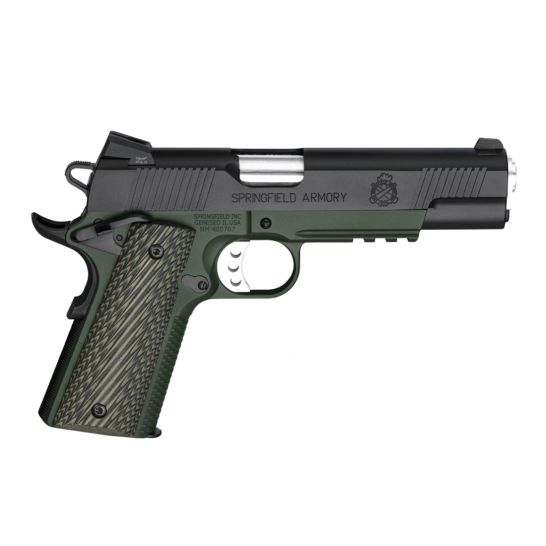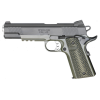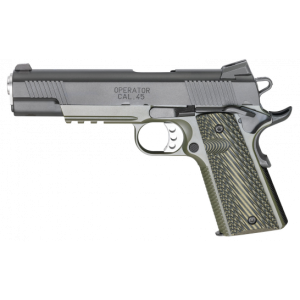Springfield 1911 MC Operator .45ACP Pistol – PX9110ML For Sale
$1,149.99
What 1911 does the Marine Corps use?
The Marine Corps uses the Colt M45A1 CQBP (Close Quarters Battle Pistol), which is based on the M1911 design.
Is Springfield Operator good?
In order to determine if Springfield Operator is good, it would depend on various factors such as the context in which the operator is being evaluated—whether it’s a business, a piece of infrastructure, or another entity—along with specific criteria like performance, service quality, customer satisfaction, and reliability. Additional information would be required to provide a definitive answer.
Are springfield 1911s forged or cast?
Springfield Armory 1911s primarily use forged frames and slides. Forging is generally preferred for its strength and durability, and Springfield Armory utilizes this method to ensure the reliability and performance of their 1911 pistols.
How much is the Springfield 1911 DS?
The price of a Springfield 1911 DS can vary depending on the specific model, features, and retailer. Typically, these firearms can range from around $1,499 to over $3,499. For the most accurate and up-to-date pricing, it’s best to check with authorized retailers or the official Springfield Armory website.
What 1911 do special forces use?
Special forces units have historically used a variety of firearms, including 1911-style pistols. One of the most commonly used versions is the Colt M1911 or its modernized versions like the M1911A1. Additionally, other manufacturers produce 1911-style pistols that have been adopted by different special forces, such as the Kimber Warrior or the Springfield Armory Operator. These pistols are favored for their reliability and powerful .45 ACP round.
What gun does USMC infantry use?
The primary service rifle used by the U.S. Marine Corps infantry is the M27 Infantry Automatic Rifle (IAR). It is designed as both a standard rifle and a light machine gun and is based on the Heckler & Koch HK416. However, the M4 Carbine is still used by some units. Additionally, the Marines use a variety of other firearms depending on the specific unit and mission, including the M249 SAW, M240B machine gun, and the M16A4 rifle in some cases.
Is Springfield Armory out of business?
No, Springfield Armory is not out of business. It is an American firearm manufacturer that is still operational.
What does TRP stand for in Springfield Armory?
In Springfield Armory, TRP stands for Tactical Response Pistol.
Who makes guns for Springfield Armory?
Springfield Armory, Inc., a privately held firearms manufacturer located in Geneseo, Illinois, is responsible for producing its own firearms. The company designs and manufactures a wide range of firearms, including handguns and rifles, under the Springfield Armory name.
Did the military use Springfield 1911?
Yes, the military used the M1911, which was designed by John Browning and produced by several manufacturers, including Springfield Armory. The M1911 was adopted by the U.S. military in 1911 and was the standard-issue sidearm for the U.S. Armed Forces for many decades, seeing extensive use in both World Wars, the Korean War, and the Vietnam War, among other conflicts.
How can you tell if its forged or cast?
To determine if a metal part is forged or cast, you can consider several characteristics and techniques:
1. **Surface Texture**:
– *Forged parts* typically have a smoother surface and may show signs of die marks or flow lines.
– *Cast parts* often have a rougher surface texture due to the casting mold and may exhibit more noticeable imperfections.
2. **Parting Lines**:
– *Cast parts* usually have more pronounced and irregular parting lines, reflecting the edges of the mold sections.
– *Forged parts* might have lighter or smoother parting lines, as the process involves pressing metal into shape.
3. **Strength and Ductility**:
– *Forged components* are generally stronger and more ductile due to the grain structure being aligned with the shape of the part.
– *Cast components* might lack such grain flow alignment, making them less strong and more brittle.
4. **Sound Test**:
– When lightly tapped with a hammer, *forged parts* usually produce a clear ringing sound.
– *Cast parts* may sound duller due to the natural porosity and microstructure.
5. **Complexity of Shapes**:
– *Cast parts* can often be more complex in shape, as casting allows for intricate designs.
– *Forged parts* are typically simpler, as forging involves compressing metal into shape.
6. **Weight**:
– Since casting doesn’t compress the material, *cast parts* can often be slightly lighter than an equivalent *forged part*.
7. **Examination Techniques**:
– **X-ray or Ultrasonic Testing**: These methods can reveal internal structures. Castings might show porosity or inclusions.
– **Grain Structure Analysis**: A microscopic analysis of the metal can reveal finer, more directionally aligned grains in forged parts compared to cast ones.
8. **Documentation**:
– Checking for accompanying material certifications or manufacturing documents can also clarify if a component was forged or cast.
These checks can help differentiate between forged and cast parts, though sometimes a combination of methods is necessary for a definitive assessment.
What is the difference between Colt M1911 and M1911A1?
The primary differences between the Colt M1911 and the M1911A1 are as follows:
1. **Backstrap**: The M1911A1 has a curved backstrap, which provided a more ergonomic grip compared to the straight backstrap of the original M1911.
2. **Trigger**: The M1911A1 features a shorter trigger to accommodate a wider range of hand sizes and improve shooting comfort relative to the M1911’s longer trigger.
3. **Finger Relief Cuts**: The M1911A1 includes finger relief cuts (cut-outs) behind the trigger guard to make it easier for shooters with shorter fingers to comfortably access the trigger.
4. **Hammer Spur**: The hammer spur on the M1911A1 was shortened to prevent it from digging into the shooter’s hand during recoil, which could be an issue with the longer hammer spur on the M1911.
5. **Grip Safety**: The M1911A1 grip safety had an extended spur to further protect the shooter’s hand from contact with the hammer.
6. **Sights**: Enhancements were made to the sights on the M1911A1, which were slightly larger to improve target acquisition over the smaller sights on the M1911.
These modifications in the M1911A1 were primarily designed to enhance the ergonomics and handling of the firearm while retaining the robust design of the original M1911.
What 1911 does the FBI use?
The FBI uses a custom version of the 1911 pistol made by Springfield Armory, known as the Professional Model or the Springfield Custom Professional 1911. This firearm has been specifically tailored to meet the FBI’s Hostage Rescue Team (HRT) requirements and is known for its reliability, accuracy, and durability.
Are Springfield 1911 made in USA?
Yes, Springfield Armory’s 1911 pistols are made in the USA.
What is a double-stack 1911?
A double-stack 1911 is a variation of the classic 1911 pistol design that features a wider grip to accommodate a larger, staggered magazine that holds more rounds. The traditional 1911 pistol typically has a single-stack magazine, which limits its ammunition capacity. The double-stack configuration increases the capacity significantly, making it appealing for competitive shooting or personal defense. The design retains the 1911’s characteristic features, such as its trigger mechanism, ergonomics, and operating system, while providing the benefit of increased firepower.
Be the first to review “Springfield 1911 MC Operator .45ACP Pistol – PX9110ML” Cancel reply
Related products
Springfield 1911 MC Operator



Reviews
There are no reviews yet.